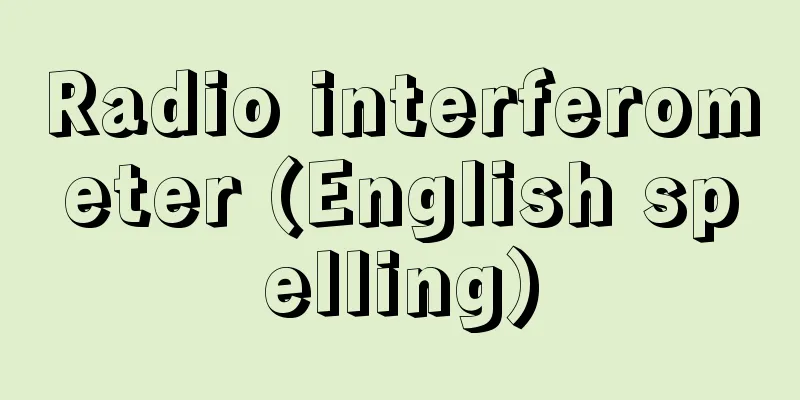Radio interferometer (English spelling)

|
A type of radio telescope. A device that combines multiple small radio telescopes (antennas) to achieve the same resolution as a giant radio telescope, which is impossible to achieve with a single antenna. The basis is a two-element radio interferometer using two antennas. Using the same principle as optical interference, when radio waves from a celestial object received by each antenna are superimposed, they strengthen or weaken each other depending on the direction of the celestial object. As a result, the interferometer on Earth emits a regular sinusoidal signal, or radio interference fringes, as the direction of the celestial object changes due to the Earth's rotation. The amplitude and phase of these interference fringes contain information about the position of the celestial object and the distribution of its brightness. In principle, even with just two antennas, two-dimensional radio photographs of celestial bodies can be obtained by observing with various antenna spacing (baseline length) and directions, and then performing a mathematical process called Fourier transform on the accumulated interference fringe data. This is the principle of aperture synthesis. Usually, multiple antennas are combined to obtain radio photographs more efficiently, and the change in baseline caused by the Earth's rotation is used. In general, the resolution of a telescope is determined by the ratio of its aperture to the wavelength. Therefore, to obtain the same resolution as an optical telescope with an aperture of 10 centimeters, a telescope with an aperture of 2 kilometers is required for radio waves with a wavelength of 1 centimeter. For this reason, interferometer technology has been used for a long time in radio astronomy. The millimeter wave interferometer at the National Astronomical Observatory of Japan's Nobeyama Radio Observatory is made up of six 10-meter antennas, with a resolution equivalent to that of a radio telescope with a maximum diameter of 600 meters. The Very Large Array (VLA) in New Mexico, USA, is made up of 27 25-meter antennas, making it the largest radio interferometer in the world. Very Long Baseline Interferometry (VLBI) is a radio interferometer whose baseline length is extended to more than several thousand kilometers. [Masato Ishiguro] [Reference] | | | |©Shogakukan "> Principle of two-element radio interferometer The radio interferometer is made up of six 10m diameter antennas connected by cables (four of them are shown in the photo). It has the same resolution as a radio telescope with a maximum diameter of 600m. Nobeyama Radio Observatory Minamimaki Village, Minamisaku District, Nagano Prefecture ©National Astronomical Observatory of Japan "> Nobeyama Radio Observatory Millimeter Wave Interferometer 27 parabolic antennas are arranged in a Y-shape to function as a giant radio telescope. It has achieved many accomplishments, including the discovery of ice on Mercury and supermassive black holes. Socorro, New Mexico, USA ©NRAO/AUI/NSF "> The National Radio Astronomy Observatory's Very Large Interferometer… Source: Shogakukan Encyclopedia Nipponica About Encyclopedia Nipponica Information | Legend |
|
電波望遠鏡の一種。小型の電波望遠鏡(アンテナ)を複数組み合わせて、単一のアンテナでは実現不可能な巨大な電波望遠鏡と等価な解像力を得る装置。基本となるのは、2台のアンテナを使った二素子電波干渉計である。光の干渉と同じ原理で、それぞれのアンテナで受信した天体からの電波を重ね合わせると、天体の方向により強め合ったり、弱め合ったりする。この結果、地球上の干渉計からは地球の自転による天体の方向の変化に伴い、規律正しい正弦波状の信号、つまり電波の干渉縞(じま)がでる。この干渉縞の振幅と位相には、天体の位置、明るさの分布についての情報が含まれている。 原理的には、わずか2台のアンテナでも、アンテナ間隔(基線長)と方向をいろいろ変えて観測し、蓄積された干渉縞のデータをフーリエ変換という数学的な処理を行うことにより、天体の二次元電波写真が得られる。これが、「開口合成法」の原理である。通常は、より効率的に電波写真を得るため、複数のアンテナを組み合わせ、しかも地球の自転による基線の変化を利用する。一般に望遠鏡の解像力は、波長に対する口径の比で決まる。したがって、口径10センチメートルの光学望遠鏡と同じ解像力を得るには、波長1センチメートルの電波では2キロメートルもの口径が必要となる。このため、電波天文学では古くから干渉計の技術が使われてきた。 国立天文台野辺山(のべやま)宇宙電波観測所にあるミリ波干渉計は、口径10メートルのアンテナ6台を組み合わせ、最大600メートルの電波望遠鏡に匹敵する解像力を有する。アメリカのニュー・メキシコ州にある超大型電波干渉計VLA(Very Large Array)は、口径25メートルのアンテナを27台組み合わせたもので、電波干渉計としては世界最大規模。電波干渉計の基線長を数千キロメートル以上に伸ばしたものが超長基線電波干渉計(VLBI)である。 [石黒正人] [参照項目] | | | |©Shogakukan"> 二素子電波干渉計の原理 ケーブルでつながれた口径10mのアンテナ6台からなる電波干渉計(写真はそのうちの4台)。最大直径600mの電波望遠鏡と同等の解像力をもつ。野辺山宇宙電波観測所 長野県南佐久郡南牧村©国立天文台"> 野辺山宇宙電波観測所ミリ波干渉計 27基のパラボラアンテナをY字形に配列し、巨大な電波望遠鏡として観測を行う。水星の氷や超巨大ブラックホールの発見など、数多くの成果をあげた。アメリカ ニュー・メキシコ州 ソコロ©NRAO/AUI/NSF"> アメリカ国立電波天文台超大型干渉電波望… 出典 小学館 日本大百科全書(ニッポニカ)日本大百科全書(ニッポニカ)について 情報 | 凡例 |
<<: Radio wave supervision - denpakanri
Recommend
Yabumyoga - Yabumyoga
A perennial herb of the Commelinaceae family (APG...
Sea of Stones - Senoumi
Suruga But South of the bay, Omaezaki Omaezaki A ...
Piccard, Jacques
Born: July 28, 1922, Brussels, Belgium [Died] Nove...
Kilogram - kilogramme (English spelling) French
The base unit of mass in the metric system and th...
Ritual Kinship
…In industrial societies, because wages are paid ...
Tax offender - tax offender
Crimes directly related to the imposition, collect...
Back three bunches - Ushirosanbou
…Three famous people whose names contain the char...
bhukti
The Gupta Empire reorganized the Indian ruling sy...
Watson-Crick (English)
…In most DNA molecules, the two strands are arran...
Indricotherium
...The scientific name comes from the beasts of B...
Airborne Mobile Force - Airborne Mobile Force
… In recent years, mechanization has progressed i...
White atractylodes pilgrimage - Okeramairi
This is an event where worshippers visit Yasaka S...
Thickener - thickener
A continuous settling and thickening device that ...
Franks, AW
…Artifacts said to have been excavated in 1877 be...
neutron capture
…As in other nuclear reactions, radioactive captu...

![Tomiura [town] - Tomiura](/upload/images/67cc5ae39c218.webp)







